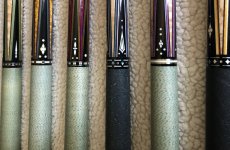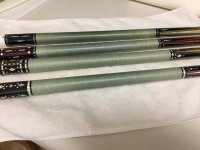This is one of my favorite cues of all time and thisisamesmister said dacron was installed and it was Rays preferred wrap. I believe a friend of Rays used to list here and I pm'd him that I would gladly give Ray as much as he would like for any cues he wanted to wrap or have built. Shooter08

Ray Martin's Balabushka
Ray Martin's personal Balabushka. George made this masterpiece for Ray circa 1970. Interesting inlay pattern in butt sleeve, look like "angel's wings". Imagine how many 100+ ball runs this cue is responsible for.
forums.azbilliards.com


